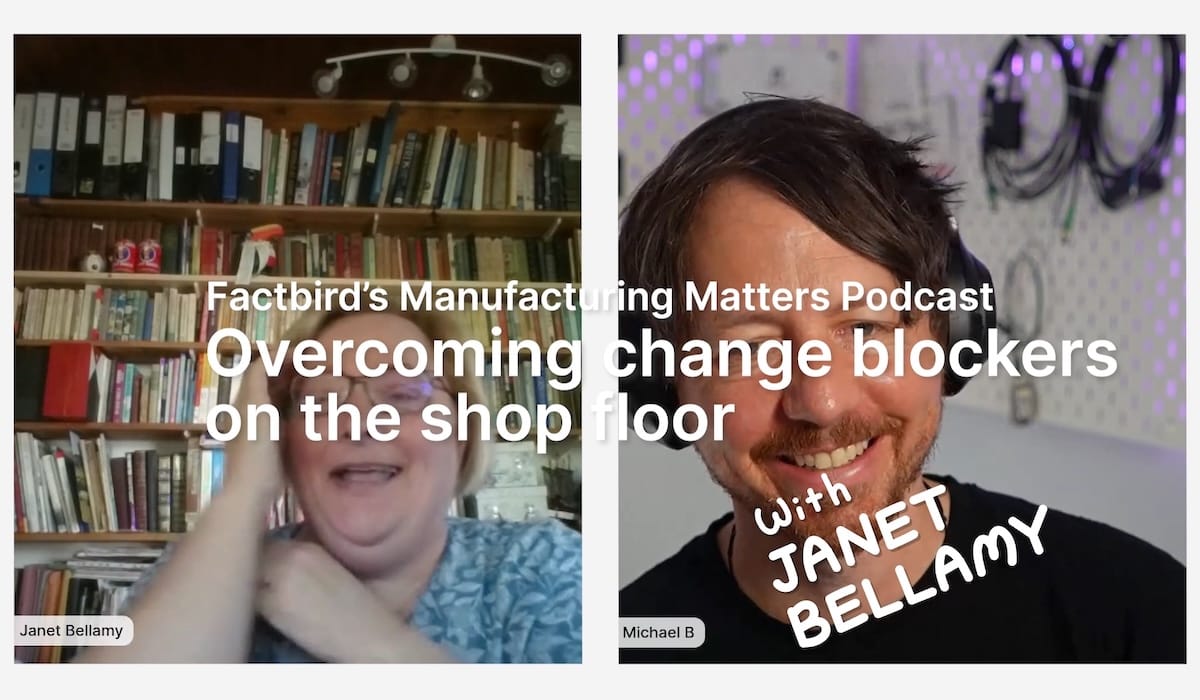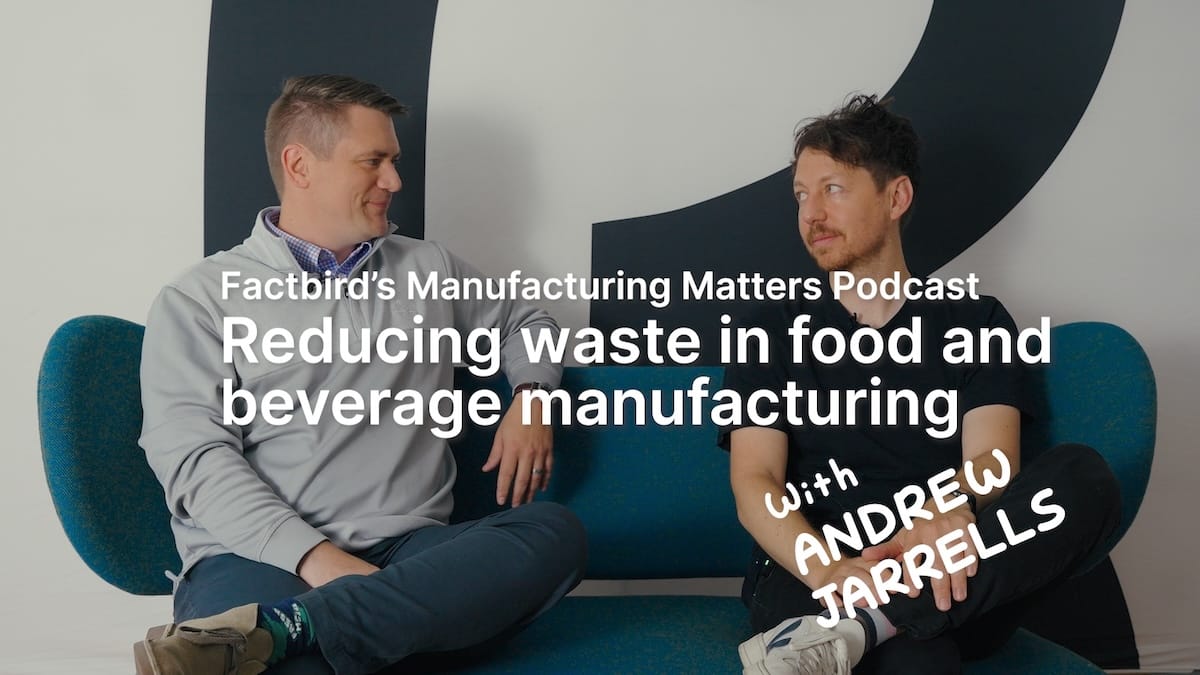Overcoming blockers to change in manufacturing
Manufacturing Matters S02E04
Featuring Janet Bellamy from the University of Lincoln
Release date: October 10, 2025

Change in manufacturing is unavoidable; new technologies, processes, and ways of working are necessary to stay competitive. The challenging part is making positive changes stick.
In this episode, we speak with Janet Bellamy from the University of Lincoln about blockers to successful change management in manufacturing and how to overcome them.
Introduction to Janet Bellamy and the University of Lincoln
Janet works at the heart of the UK’s “Food Valley,” where a large number of well-known UK food manufacturers operate. She is part of the team at the National Center for Food Manufacturing at the University of Lincoln and leads the research into digital and emerging technologies.
“We’re there predominantly to serve the industry with skills provision, with research, with consultancy advice, and support.”
– Janet Bellamy, University of Lincoln
She has 35+ years of experience in the manufacturing industry, including leading teams and designing new factories and processes. Now, she mostly looks at “real-world challenges for industry and how the research that is there can solve those problems.”
Why change is necessary in manufacturing
Change isn’t optional; it shows up at every level of the business. As Janet notes, the economy, the operating environment, and shifting consumer demand all “put pressure on manufacturers.”
That pressure lands differently for operators, engineers, supervisors, and leadership, but it affects everyone.
Here are some examples of what’s driving the need for successful change management in manufacturing:
From bulk to variety: Many food and beverage lines were designed as bulk systems optimized for volume with long, stable runs. Today, retailers and consumers want more unique products requiring shorter runs and faster changeovers. Processes built for bulk production struggle with change.
Tighter margins, higher expectations: Volatile input costs and service-level pressure mean less room for waste and less time to decide. You need clarity in real time across shifts, batches, and sites to stay on plan.
Compliance and sustainability: Requirements around traceability, quality, and energy use keep rising. That adds data and documentation work, plus extra cognitive load for operators in particular.
Labor and skills shortages: Hiring, onboarding, and planning for the future of work at your business remain tough. If change makes the day harder for operators or supervisors, it won’t stick.
Janet emphasizes that “there isn't something off the shelf that you can just drop into a business to solve that problem.” As Janet says, “Historically, if you've run out of capacity or you want to change a product, you just buy another piece of machine, or you extend the shed. You can't extend the factory anymore; you know, you've got to think of this in a different way.”
“What we’re talking about is doing more with less.”
– Janet Bellamy, University of Lincoln
Factories need to upgrade equipment, people, and processes, particularly in the food and beverage sector, where change has been slower compared to automotive, aerospace, and pharmaceuticals, for example.
In general, the question isn’t whether to change; it’s about how to do it successfully. Because if you haven’t started that journey, you will find yourself behind everyone else and having to catch up.
Change blockers: people and technology
In the podcast, Janet broke down blockers to change in manufacturing into two distinct areas.
1) The people side
Janet highlights people as the biggest blocker to change. It’s not just people on the shop floor, it’s about management and up to the board as well.
“They see automation and robotics coming in and think, well, I’m out… they’re replacing me with a machine.”
– Janet Bellamy, University of Lincoln
Focusing on the shop floor workforce, change is uncomfortable for people, and job anxiety is real, especially when automation is on the agenda. Janet says it’s important to know the goal isn’t replacement; it’s upskilling and moving people into higher-value work. Even with massive automation, open jobs are piling up in the US and beyond.

Additionally, if leadership treats digital and process change as optional, adoption stalls.
According to Janet, “There is a real blocker at board level and management level… if we’re not embracing this at board level and understanding the opportunities, we’re not going to bring our teams along.”
In general, perception poses a significant obstacle to progress.
2) The technology side
We all talk about plug-and-play and interoperability a lot in the manufacturing software space, but reality is messier.
“This whole thing is built on interconnectivity and interoperability… But in reality, you try and connect another machine up to it… It becomes a mammoth task.”
– Janet Bellamy, University of Lincoln
Interoperability is a big barrier in all areas of technology, but it’s something that the manufacturing industry needs to get better at to enact sustainable change.
As Janet puts it, “A factory may well have seven machines in from seven different suppliers; those machines should be able to talk to each other, and they can't.” She adds, “It's via an API link. It's not real time. There's all sorts of challenges in the meantime. And certain manufacturers just won't let you have access to that data or their systems. So we've got to do something with that to be able to get past it.”
What works: clear communication and co-design
Communication is the through-line in projects that succeed.
The teams that land change well are good at setting clear expectations from the outset. Involve people early, and design with them, not for them. Janet says, “Where the communication is very clear and honest… it nearly becomes this sort of co-design process.”
She highlights that it’s important to capture information from all levels of the workforce to make sure the design process is robust. Before you automate or rewrite a workflow, make the current state visible. Janet’s team uses process mapping across all levels: operators, supervisors, engineering, and support functions.
“We process map with businesses, but we do it across all levels of the organisation.”
– Janet Bellamy, University of Lincoln
The effect is immediate. According to Janet, “It’s surprising how many teams… are quite surprised at what is actually real… There’s an assumption that processes are being followed… When you bring shop floor staff in… people again start to look at what’s actually going on in the business.”
This is where hidden inefficiencies quickly surface. Workarounds added after incidents, extra checks that nobody ever removed, and “nonsense activities that are there just because.” Once you can see these issues, you can remove or redesign them.
Start small, think big, and earn trust with visible wins
Change sticks when it proves value fast. Janet’s advice is to start small by targeting improvements the shop floor will feel this week while keeping a bigger direction in view. The point isn’t doing everything at once; it’s building credible wins that build momentum and a shared language for what comes next.
In food and beverage, that often means taking time to tune what you already have. For example, balancing compressors and optimizing defrost cycles can deliver immediate energy savings, tangible proof that change helps the line, not just the KPI sheet. Once people see those gains, it’s easier to align on larger steps.
“How many people have actually gone back in and balanced compressors or balanced the way that the defrost cycles work… Because straightaway that’ll save you 30%.”
– Janet Bellamy, University of Lincoln
Just as important is speaking the right language to your audience:
- Operators care about a smoother shift and fewer headaches.
- Supervisors care about hitting the plan.
- Leaders care about sustained performance and reducing risk.
Frame each win in terms that matter to them, and close the loop so teams see how their input shaped the outcome. That’s how small, practical wins turn into confidence, and confidence creates room for bigger moves.
To help operators have smoother shifts and fewer headaches, Factbird recently launched Operator View, an intuitive interface that reduces operator workload, improves the accuracy of data, and helps to keep production flowing smoothly: Operator View.
What the future holds for manufacturing
To finish the podcast, I asked Janet what’s vital for people in food and beverage manufacturing to consider over the next five years.
For Janet, the focus is clear, “Digitalization and AI is an absolute no brainer.” So long as you use them wisely to drive real improvements.
For digitalization in manufacturing, that means real-time, targeted data rather than “warehouses full of paper,” and only keeping what actually adds meaning to performance.
On AI, the message is don’t be afraid: machines can take thousands of micro-decisions where humans can take ten; the point is to choose where AI unlocks real value in your processes.
Do these things well, and sustainability follows; efficiency gains move you toward your net-zero goals as a by-product.
“It's about having data at your fingertips in real time and only keeping and processing the data that's actually adding meaning to what you're trying to achieve.”
– Janet Bellamy, University of Lincoln
Find out more
Make sure you check out the full podcast episode for all of the valuable insights Janet had to share. And if you’d like to get in touch with Janet Bellamy to learn more, here are a few options:
Email: jbellamy@lincoln.ac.uk
LinkedIn: Janet Bellamy
Website: National Centre for Food Manufacturing
And for more content on helpful manufacturing topics, please subscribe to Factbird’s Manufacturing Matters podcast on Spotify, Apple Podcasts, YouTube, Amazon Music, or your favorite podcast platform.
If you have topics you'd like us to cover or ideas for future guests, feel free to reach out to me via LinkedIn or the Factbird marketing team at marcom@factbird.com.


.svg.png)


